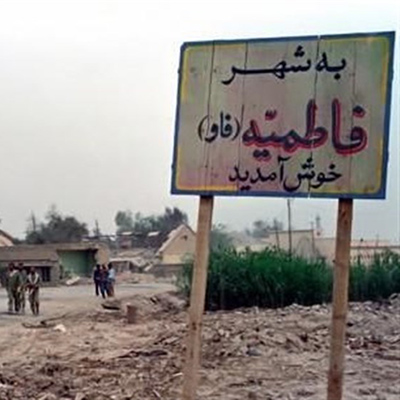Sites
Al-Faw
Written by: Mohsen Shirmuhammad,
Translated by: Hadi Qorbanyar
125 Views
The Al-Faw Peninsula was one of the most important regions of Iraq, which was captured by Iranian forces in 1986 during Operation Valfajr 8.
Located at the southernmost point of Iraqi territory, in the northwest of the Persian Gulf, the Al-Faw Peninsula is surrounded on three sides by water: to the north by the Arvand River, to the south by Khor Abdullah and Kuwait, and to the east by the Persian Gulf. Its only land connection lies to the west, leading to Basra. The terrain of Al-Faw consists predominantly of marshes, salt flats, and unstable ground. Except for the area between the Arvand River and the first Faw–Basra Road, which contains arable soil, the rest of the region consists predominantly of saline wasteland. During rainfall, the soil becomes both slippery and adhesive, making vehicle movement—especially heavy equipment and tanks—almost impossible. The region was served by three main roads: the 82-kilometer Faw–Al-Bahar, the 91-kilometer Faw–Basra, and the 50-kilometer Faw–Umm al-Qasr.[1]
Before the Iran–Iraq War, Al-Faw had a population of 42,000, which decreased to 3,000 due to the displacement of residents during the conflict.[2]
The naval installations of Al-Faw, together with Umm al-Qasr on the banks of Khor Abdullah and the Basra Port, formed Iraq’s three major naval bases during the war.[3] Al-Faw itself possessed only a limited number of piers suitable for light craft and shallow-draft vessels, and even these were rarely utilized.[4] After the outbreak of the Iran-Iraq War in 1980, six Yugoslav-built patrol boats were stationed at Al-Faw.[5]
The city also hosted three missile launch bases.[6] From 1983[7] onward, Iraq used these sites, equipped with Silkworm missiles, to target Iranian oil facilities and vessels in the Persian Gulf, particularly around Kharg Island.[8] The first base was located at the lower part of the Al-Faw plain near the mouth of the Persian Gulf and close to Khor Abdullah; the second was to the right of the Faw–Umm al-Qasr Road; and the third to the left of the same road.[9] With a range of 90 kilometers, these missiles made the mouth of Khor Musa unsafe for ships bound for Bandar Imam Khomeini and Mahshahr.[10]
Al-Faw also contained dozens of massive oil storage tanks. About 90 percent of Iraq’s oil exports were processed in this area and transported by pipeline to the offshore terminals of Al-Bakr and Al-Amiya, located 32 kilometers out at sea. The largest salt lake and saltworks in Iraq were located in the northwest of Al-Faw. Extensive date groves, abundant date production, and the presence of docking facilities all added to the region’s strategic value.[11]
One day after Iraq’s large-scale aerial attack on Iran, Iranian fighter jets, as part of Operation Kaman 99 (September 23, 1980), targeted the military facilities of the Al-Faw Port.[12] To counter Iraq’s naval capabilities, Iranian aircraft operating from Bushehr Air Base conducted airstrikes against installations in Basra, Al-Faw, and Umm al-Qasr,[13] with repeated attacks on Al-Faw’s oil infrastructure in an effort to cripple Iraq’s petroleum export capacity.[14] For example, F-4 aircraft from the 6th Bushehr Air Base bombed Al-Faw on September 27, October 4, and October 21, 1980.[15]
Throughout the Iran–Iraq War, the Al-Faw region was under the operational command of Iraq’s Seventh Corps, which secured the Arvand River with the 15th and 26th infantry divisions in coordination with naval forces.[16] On February 9, 1986, Operation Valfajr 8 began with the objective of capturing Al-Faw. By crossing the Arvand River between Khosroabad and Ras al-Bishah, the Islamic Revolutionary Guard Corps (IRGC) forces seized the city of Al-Faw, its oil installations, and surrounding villages. The operation severed Iraq’s direct access to the Persian Gulf, secured three Iraqi surface-to-sea missile bases and a naval base, ensured safe navigation in the northern Persian Gulf, and enabled maritime access to Badar Imam Khomeini.[17]
After 75 days of continuous fighting, involving 18,648 combat sorties and extensive aerial bombardment, the Iraqi army, having failed to recapture Al-Faw, ultimately stopped its counteroffensive operations.[18] During the operation, Iranian air defenses shot down 72 Iraqi fighter jets,[19] around 17,000 Iraqi troops were killed, and 770 square kilometers of Iraqi territory fell under Iranian control. Also, Iranian forces advanced to within 20 kilometers of Umm al-Qasr,[20] effectively making Iran a direct neighbor of Kuwait.[21]
Following the capture of Al-Faw, the Jahad-e Sazandegi Organization proposed a project to facilitate crossings of the Arvand River. Two strong steel cables were stretched parallel across the river, with a large floating platform, called “doobeh”, moving along their length. A third cable, connected between the floating platform and a tractor wheel, provided forward and backward movement. This platform became known as the “khezr movable bridge”.[22] Later, it was decided to construct a permanent bridge across the river. The project was carried out by the engineering corps of the Karbala Headquarters (Jahad-e Sazandegi), supported by the Khatam Al-Anbiya (pbuh) Headquarters and the central support staffs of the Khorasan and Khuzestan branches of Jahad-e Sazandegi.[23] A bridge measuring 600 meters in length, 12 meters in width, and 8 meters in depth was built using 3,400 pipes, each with a diameter of 56 inches. Installation of the bridge, named Besat, began on May 31, 1986—about three and a half months after Operation Al-Faw—and was completed on September 19, 1986.[24]
On Sunday, April 17, 1988, the Iraqi army launched Operation Ramazan al-Mubarak to take control of the Al-Faw region.[25] The Iraqi army employed aerial bombardments to destroy logistical bridges, including the Abadan and Arvand (Besat) bridges, while using chemical weapons to neutralize Iranian artillery and equipment. In the first hours of the attack, nearly 2,000 casualties from nerve agents were transferred to the Abu al-Fazl (as) chemical hospital in Al-Faw, while about 500 others were taken to the Fatemah Zahra (s) field hospital. After the first day’s airstrikes, Iraqi ground forces with four divisions attacked Iranian positions from three axes: Umm al-Qasr, the strategic road, and the Al-Bahar Road.[26] In addition, 200 combat divers attacked Iranian forces from their rear positions.[27] Two marine brigades under Republican Guard command also took part in the amphibious counteroffensive[28] to recapture Al-Faw.[29] They were supported by amphibious ships armed with Katyusha rocket launchers.
Finally, on April 18, 1988, Iraq recaptured Al-Faw. During the Iraqi attack, over 230 Iranians were martyred, 300 taken as prisoners, and about 400 went missing in action. The Iraqi army suffered relatively few casualties in the attack. Al-Faw remained under Iranian control for a total of 28 months, from February 1986 to April 1988.[30] In the years following the Iran–Iraq War, the Iraqi government sought to develop the Al-Faw region. The Al-Faw Port project began in 2010 but faced delays due to various challenges,[31] including opposition from Kuwait.[32] In 2020, Iraq signed a $2.6 billion agreement with the South Korean engineering company Daewoo to construct the first phase of the port over a four-year period. The port is expected to begin operations in 2024 and be fully completed by 2025.[33]
[1] Mirzaei, Reza, Hamaseh-ha-ye Namdaran-e Gomnam (Epics of Unknown Heroes), Tehran, Bonyad Hefz-e Asar va Nashr-e Arzesh-ha-ye Defa Muqaddas, 1st ed., 1394, p. 504.
[2] Torab Zamzami, Abdolmajid, Jang-e Iran va Araq (The Iran–Iraq War), trans. Mozhgan Nazhand, Tehran, Safir, 1368, p. 195.
[3] Shirmuhammad, Mohsen, Bar Faraz-e Daryaha: Negahi be Tarikh-e Havadarya va Hamase-ye Eskadran-ha-ye Havanav, Balgard va Bal-e Sabet dar Jang-e Tahmili (Above the Seas: History of Naval Aviation and Helicopter Squadrons in the Iran–Iraq War), Tehran, Daftar-e Pazhuhesh-ha-ye Nazari va Motaleat-e Rahbordi-ye NEDAJA, 1400, p. 259.
[4] Alaei, Hussain, Ravand-e Jang-e Iran va Araq, Vol. 2 (Course of the Iran–Iraq War, Vol. 2), Tehran, Marz va Boom, 1391, p. 196.
[5] M. Woods et al., Jang-e Iran va Araq az Didgah-e Farmandehan-e Saddam (The Iran–Iraq War from Saddam’s Commanders’ Perspective), trans. Abdolhamid Heydari, Tehran, Marz va Boom, 1393, p. 302.
[6] Mirzaei, Reza, Hamaseh-ha-ye Namdaran-e Gomnam (Epics of Unknown Heroes), 44th ed., Tehran, Bonyad Hefz-e Asar va Nashr-e Arzesh-ha-ye Defa Muqaddas, 1399, p. 504.
[7] M. Woods et al., Ibid., p. 281.
[8] Mirzaei, Reza, Ibid., p. 504.
[9] Niyazi, Yahya, Jaddeh-ye Estratijik-e Faw–Basra (Strategic Road Al-Faw–Basra), Tehran, Markaz-e Asnad va Tahqiqat-e Defa Muqaddas, 1391, p. 69.
[10] Shiraliniya, Jafar, Mowj-e Sorkh (The Red Wave), Tehran, Fatehan, 1391, p. 121.
[11] Mirzaei, Reza, Ibid., p. 504.
[12] Heyat-e Tadvin-e Tarikh-e Defa Muqaddas, Taqvim-e Mostanad-e Amalkard-e Niroye Elahi-ye Havaei-ye Artesh-e Jomhuri-ye Eslami-ye Iran, (Documented Calendar of the Air Force’s Sacred Defense Operations), Vol. 3, Mehr 1359, Tehran, Markaz-e Entesharat-e Rahbordi-ye NAHAJA, 1397, Pp. 78–79.
[13] Nirooye Havaei dar Defa Muqaddas (The Iranian Air Force during the Sacred Defense), Tehran, Entesharat-e Iran Sabz, 1389, p. 162.
[14] Ibid., Pp. 137, 151, 152, 154, 155 and 156.
[15] Heyat-e Tadvin-e Tarikh-e Defa Muqaddas, Ibid., Pp. 215, 396, 645.
[16] Pourjabbari, Pezhman, Atlas-e Joghrafiya-ye Hamasi 1: Khuzestan dar Jang (Epic Geography Atlas 1: Khuzestan in War), Tehran, Sarir, 1389, Pp. 100–101.
[17] Ibid., p. 101.
[18] Alaei, Hussain, Ibid., p. 189.
[19] Gholami, Baratali, Padafand-e Havaei, Vol. 1: Seir-e Tosee va Takamol (Air Defense, Vol. 1: Development and Evolution), Tehran, Entesharat-e Iran Sabz, 1399, p. 210.
[20] Jafari, Muhammad, Atlas-e Nabard-ha-ye Mandegar (Atlas of Lasting Battles), Tehran, Sureh Sabz, 50th ed., 1398, Pp. 118–119.
[21] Shiraliniya, Jafar, Ibid., p. 119.
[22] Mahmoudzadeh, Nosratollah, Khakriz-ha-ye Khat-e Moqaddam, Tarikh-e Mohandesi-ye Jang-e Jahad-e Sazandegi dar Douran-e Defa Muqaddas, Vol. 2 (Frontline Earthworks: Engineering History of Jahad-e Sazandegi in the Sacred Defense, Vol. 2), Tehran, Markaz-e Asnad va Tahqiqat-e Defa Muqaddas, 1401, Pp. 309–310; Pol-e Motaharek-e Khezr (Khezr Movable Bridge), Khabargozari Mashreq, 15 Esfand 1393, 393474, www.mashreghnews.ir/news/-
[23] Mirzaei, Reza, Ibid., p. 509.
[24] Alaei, Hussain, Ibid., p. 190.
[25] Ibid., p. 432.
[26] Ibid.
[27] M. Woods et al., Ibid., p. 312.
[28] Ibid., p. 311.
[29] Ibid., p. 309.
[30] Alaei, Hussain, Ibid., p. 433.
[31] Ebtekar-e Bandar va Kanal-e Khoshk; Rahi be Sooy-e Khizesh-e Eqtesadi-ye Araq (Port and Dry Canal Initiative: Path to Iraq’s Economic Rise), ATNA, Resane-ye Tahlili Daneshgah-e Allameh Tabatabaei, 25 Bahman 1401, www.atna.atu.ac.ir/fa/news/304678
[32] Monaqeshe-ye Marzi-e Khor Abdullah va Ravabet-e Pisherowi-ye Kuwait va Araq (Territorial Dispute of Khor Abdullah and Relations Between Kuwait and Iraq), Khabargozari IRNA, 24 Bahman 1395, www.irna.ir/news/82427018
[33] Ebtekar-e Bandar va Kanal-e Khoshk; Rahi be Sooy-e Khizesh-e Eqtesadi-ye Araq (Port and Dry Canal Initiative: Path to Iraq’s Economic Rise), Ibid.





